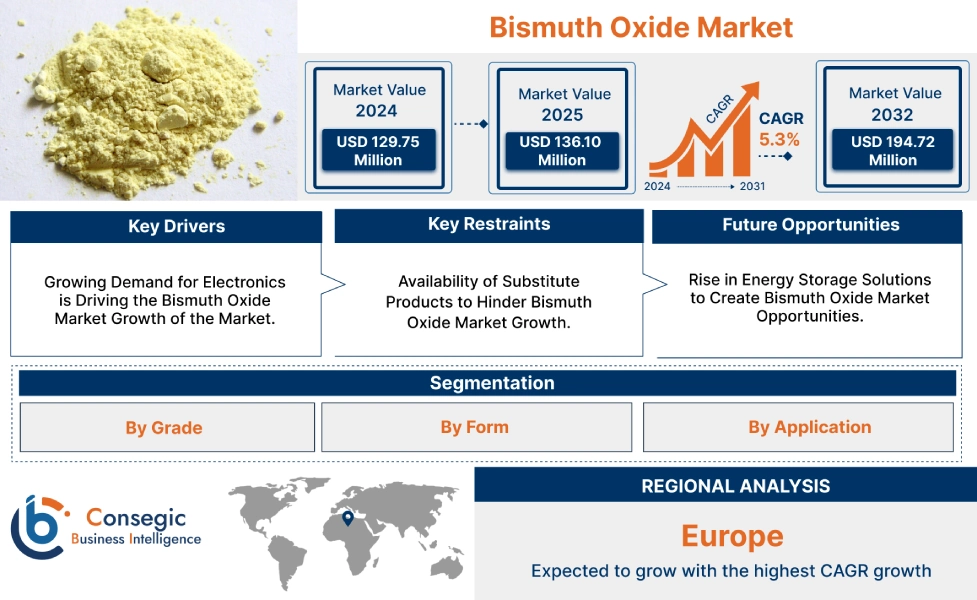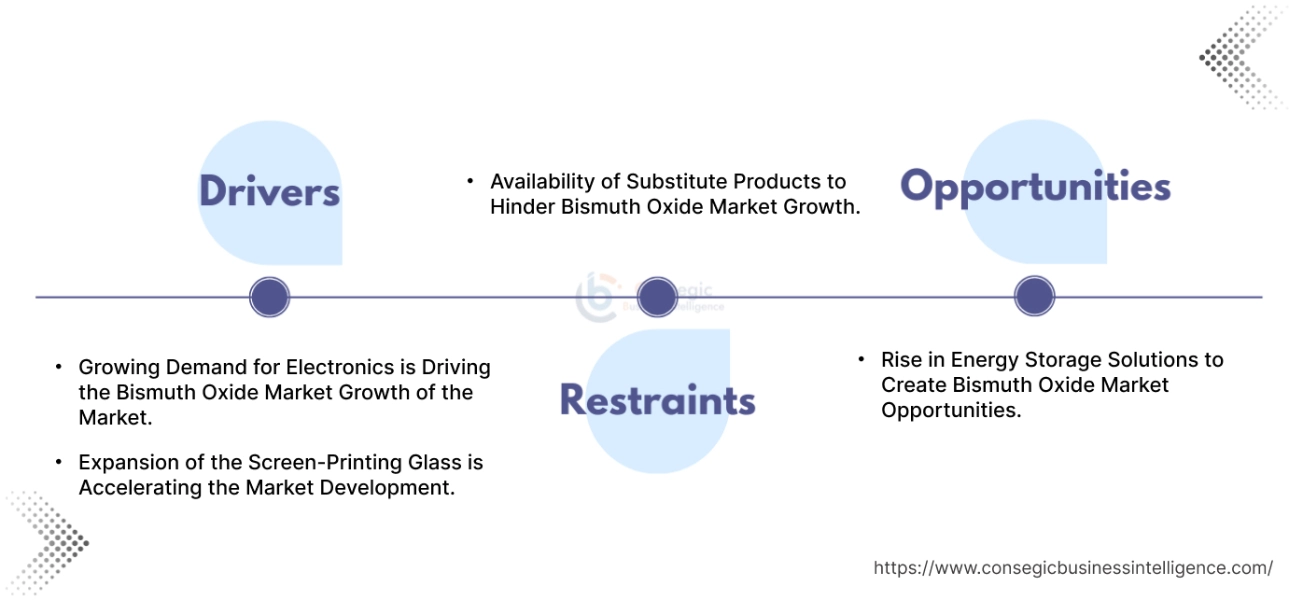Bismuth Oxide Market Size:
The Bismuth Oxide Market size is growing with a CAGR of 5.3% during the forecast period (2025-2032), and the market is projected to be valued at USD 194.72 Million by 2032 from USD 129.75 Million in 2024. Additionally, the market value for 2025 is attributed to USD 136.10 Million.
Bismuth Oxide Market Scope & Overview:
Bismuth oxide is also called as bismuth trioxide or bismuth (III) oxide. It is an inorganic compound that is produced through the combination of bismuth and oxygen. The yellow powder form is the most prevalent bismuth compound. It presents polymorphism depending on temperature. It is insoluble in water but soluble in acids. The market is categorized into grade, form, and application. The grade segment is further classified into electronic grade, technical grade, and others. Similarly, the form segment is classified into powder, pellets/granules, and others. Furthermore, the application segment is further classified into electronics and electrical, optical and glass, medical and dental, refractories and ceramics, and others.
Bismuth Oxide Market Dynamics - (DRO) :
Key Drivers:
Growing Demand for Electronics is Driving the Bismuth Oxide Market Growth of the Market.
The increase in utilization of bismuth oxide in the production of several intelligent electronic devices such as zinc oxide based varistors, ferrite magnetic materials amongst others that are an important aspect to the operation of several electric devices. The growing focus of manufacturers towards the efficiency, performance, and miniaturization of devices in the electronics sector is further contributing to the market development.
- For instance, according to Atradius N.V., the production of electronics is expected to grow by 8.2% in 2024 across the globe with focus on meeting the increased need for advanced semiconductors.
Hence, due to the aforementioned factors, growing need for electronics is driving the development of the market.
Expansion of the Screen-Printing Glass is Accelerating the Market Development.
In the growing screen-printing glass sector, bismuth oxide offers low-firing temperature fluctuations for the inorganic frit inks that are utilized in screen-printing on glass. This allows for useful curing without damaging the glass substrates. This compound also improves the durability of printed layers which makes them withstand hard conditions. With the development in end-use sectors consumer electronics glass amongst others, where screen-printing is highly preferred, the demand for this compound is significantly expanding.
- For instance, according to Pixeljet, the global screen-printing glass market experienced a growth rate of more than 5% from 2018 to 2023.
Thus, owing to the afore-mentioned factors, the rise of screen-printing glass is accelerating the bismuth oxide market expansion.
Key Restraints:
Availability of Substitute Products to Hinder Bismuth Oxide Market Growth.
The availability of substitute products acts as a considerate hurdle for market development. With small scale manufacturers where cost is a major concern, more alternatives such as zinc oxide or titanium dioxide become a suitable option for usage. In addition to this, traditional materials in several industries often have strong supply chains, creating the transition to this compound, a costly and complex undertaking for manufacturers. Therefore, the presence of these alternatives constrains bismuth oxide market expansion, primarily in price-sensitive end use industries such as certain pigments amongst others. Therefore, the above-mentioned factors are contributing to hinderance in market.
Future Opportunities :
Rise in Energy Storage Solutions to Create Bismuth Oxide Market Opportunities.
The rise in energy storage solutions provides lucrative opportunities for the market due to its applicability as a material for high-capacity anode in sodium-ion and lithium-ion batteries. Furthermore, ongoing research and developments to improve its performance for next-generation energy storage. Furthermore, bismuth oxide in the delta (δ) phase, are of high value as solid electrolytes in Solid Oxide Fuel Cells (SOFCs). The benefits offered by this compound in the growing energy storage sector are contributing to market development over the forecast period.
- For instance, according to the MINISTRY OF NEW AND RENEWABLE ENERGY, the energy storage obligations are expected to increase by 0.5% on a yearly basis by 2030
Thus, due to the aforementioned factors, trends in energy storage systems to create bismuth oxide market opportunities.
Bismuth Oxide Market Segmental Analysis :
By Grade:
Based on grade, the market is categorized into electronic grade, technical grade, and others
Trends in Grade:
- The increase in need for higher efficiency, miniaturization, and enhanced reliability in electronic devices.
The electronic grade segment accounted for the largest bismuth oxide market share in 2024 and is expected to grow at the fastest CAGR over the forecast period.
- The dominance of electronic grade is due to the growing electronics sector on a consistent basis, which needs bismuth oxide for components such as ceramic capacitors, semiconductor devices amongst others.
- The strict purity requirements in electronics are principal for assuring device performance and reliability.
- Additionally, the application of compounds in technologies, such as advanced energy storage solutions as well as the semiconductor sector, is contributing to segmental trends.
- For instance, according to the Semiconductor Industry Association, semiconductor sale increased from Feb 2023 to Feb 2024 by more than 15% and is expected to be increase over the forecast period
- Thus, as per the market analysis, based on the above-mentioned factors, the electronic grade segment dominates as well as is expected to grow at the fastest CAGR in the bismuth oxide market demand.
By Form:
The form segment is categorized into powder, pellets/granules, and others.
Trends in the Form
- The growing preference for powder form due to the wide applicability across several end-use industries such as ceramics, glass, electronics, amongst others.
- The rising focus of manufacturers towards the utilization of granules in ceramic and glass manufacturing processes.
The powder segment accounted for the largest market share of 49.04% in 2024 and is expected to grow at the fastest CAGR over the forecast period.
- Bismuth oxide in powder form is the most versatile compound due to the ease of integration across a variety of industrial processes.
- Its utilization across key end-use sectors such as electronics, ceramics, glass, and catalysis, amongst others is contributing to the segmental development.
- The high demand for this compound in electronic ceramic materials, such as for varistors and capacitors as well as it’s utilization in production of ceramic products such as ceramic tiles amongst others.
- For instance, according to Ceramic World Web, the consumption growth rate of ceramic tiles grew at an annual average growth rate of 2.2% from 2023 to 2024.
- Thus, based on the market analysis, as per the aforementioned factors, the powder segment is dominating as well as the fastest growing segment in the industry.
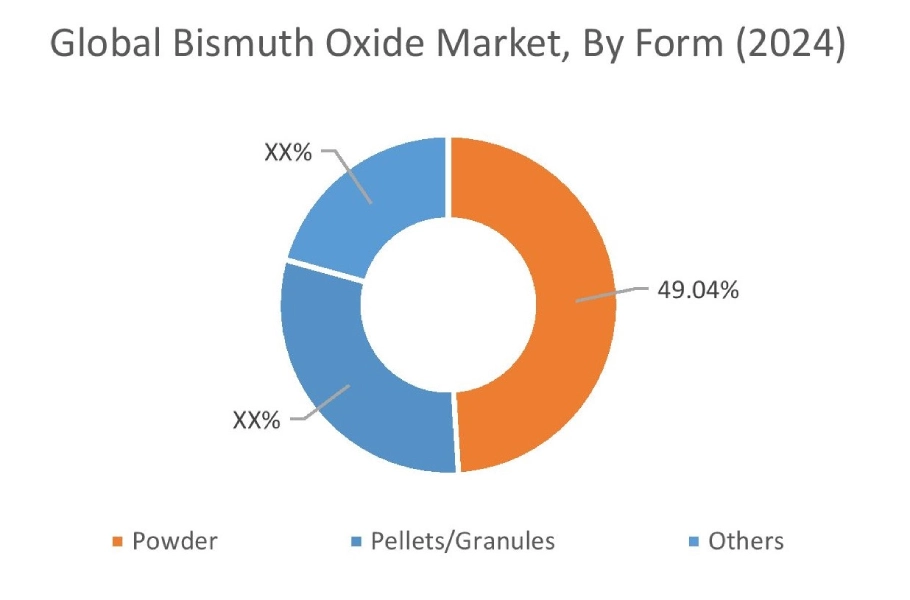
By Application:
The application segment is categorized into electronics and electrical, optical and glass, medical and dental, refractories and ceramics, and others.
Trends in the Application
- The rising inclination towards free electronic solders and components that are lead-due to environmental regulations.
- The wide adoption rate as a non-toxic flux in ceramic glazes and enamels is increasing.
The electronics and electrical segment accounted for the largest bismuth oxide market share in 2024 and is expected to grow at the fastest CAGR over the forecast period.
- Electronics and electrical segments are the dominant application segment due to the growing electronics sector, wherein bismuth oxide is considered as one of the key elements for its utilization in components such as varistors and ferrite magnetic materials amongst others.
- Additionally, the global need for lead-free solutions wherein this compound aligns with the requirement for lead-free solutions in electronic application is further contributing to market development.
- For instance, according to JEITA, the production value across the globe by electronics and IT companies in Japan is expected to growth from round USD 286 Billion in 2024 to USD 298 Billion in 2025.
- Thus, based on the market analysis, as per the aforementioned factors, the electronics and electrical segments are dominating as well as expected to grow at the fastest CAGR in the market.
Regional Analysis:
The regional segment includes North America, Europe, Asia Pacific, the Middle East and Africa, and Latin America.
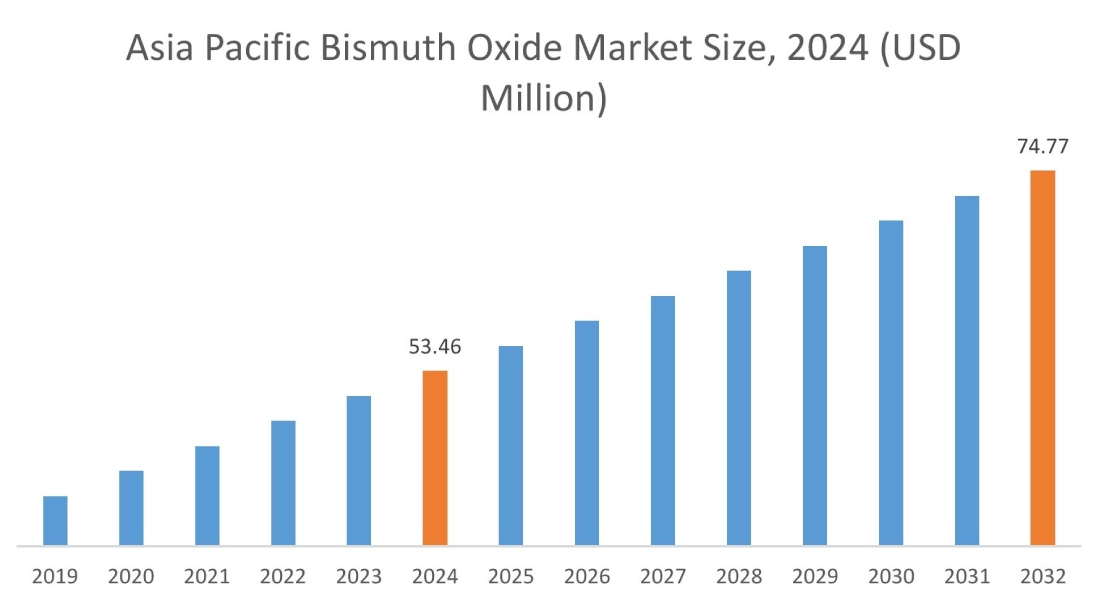
In 2024, Asia Pacific accounted for the highest market share at 41.20% and was valued at USD 53.46 million and is expected to reach USD 74.77 million in 2032. In Asia Pacific, China accounted for the market share of 40.39% during the base year of 2024. The development in the electronics sector is a primary driver for the bismuth oxide market in the Asia Pacific (APAC) region. Asia Pacific countries such as China, India and Japan being few of the major manufacturing hub for electronic components directly alters to a high requirement of this compound. This requirement is essential for advanced components that are mandatory to meet the stringent quality standards. Furthermore, the region's increasing adoption of lead-free regulations is further contributing to regional development.
- For instance, according to Dezan Shira & Associates, the electronic manufacturing sector in China is experiencing a growth rate of more than 10% on a year on basis in 2024
Based on the market analysis, these factors create a strong upward trajectory for the market in Asia Pacific, positioning it as a key region for players.
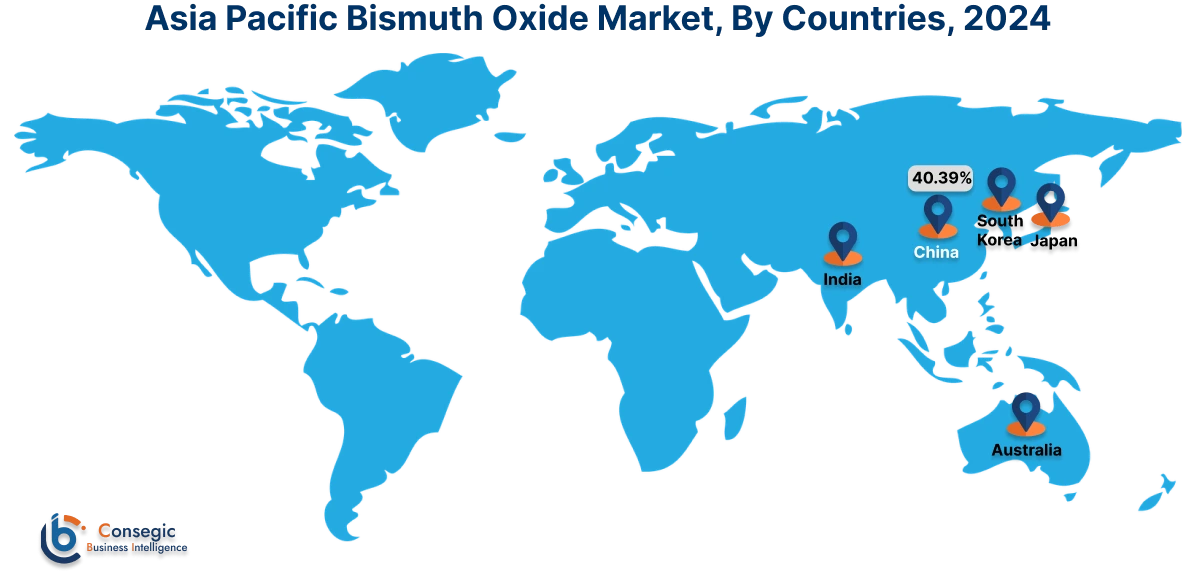
In Europe, the bismuth oxide industry is experiencing the fastest growth with a CAGR of 7.1% over the forecast period. The growing requirement for this compound for energy storage solutions is driven by factors such as a strong commitment to sustainability amongst others. European Countries such as Germany, France and UK are investing in and developing advanced battery technologies. This compound is utilized in advanced battery technologies as it acts as a promising anode material for lithium-ion batteries. These factors align with Europe's focus for more sustainable and cost-effective energy storage. These above-mentioned factors are contributing to the bismuth oxide market trends in this region
The growing ceramics and glass sector in North America is the primary factor contributing to the development of bismuth oxide due to its wide utilization in ceramics such as tiles and sanitaryware, amongst others. Additionally, the focus of North America towards lead-free solutions aligns with the benefits offered by this compound is contributing to the development in North America. Furthermore, the rising demand for specialty glass in several end use industries, where this compound enhances durability is attributing to market development. These factors contribute to market trends in North America
The Latin American market is showcasing potential for bismuth oxide in the field of AI in healthcare, medical imaging and radiopacity in healthcare. This rise in preference is due to the growing medical imaging market driven by the rising prevalence of chronic diseases amongst others. Compounds utilization as a radio pacifier in dental materials, further contributes to this development. Moreover, based on the bismuth oxide market analysis, countries such as Brazil are investing towards advancements in medical imaging, along with the usage of nanoparticles as contrast agents in X-ray CT, further contributing to the bismuth oxide market demand in Latin America's medical sector.
In the Middle East, increase in infrastructure development along with ongoing investment in chemical industries are creating potential for bismuth oxide in its utilization into construction additives, advanced coatings, and others. Furthermore, the region's growing inclination towards sustainable practices favors this compound's non-toxic profile in eco-friendly chemical formulations. Moreover, based on the bismuth oxide market analysis is also used in chemical industries further contributing to the bismuth oxide market trends in this region.
Top Key Players and Market Share Insights:
The Global Bismuth Oxide Market is highly competitive with major players providing products to the national and international markets. Key players are adopting several strategies in research and development (R&D) and product innovation to hold a strong position in the global Bismuth Oxide market. Key players in the Bismuth Oxide industry include
- American Elements (U.S.)
- Hunan Jinwang Bismuth Industrial (China)
- Shepherd Chemical Company (U.S.)
- 5N Plus Inc. (Canada)
- Satyam Pharma Chem Pvt Ltd (India)
- ESPI Metals (U.S.)
- Clark Manufacturing LLC (U.S.)
- Stanford Advanced Materials (U.S.)
- Inframat Advanced Materials (U.S.)
- TOMATEC Co., Ltd. (Japan)
Bismuth Oxide Market Report Insights :
| Report Attributes | Report Details |
| Study Timeline | 2019-2032 |
| Market Size in 2032 | USD 194.72 Million |
| CAGR (2025-2032) | 5.3% |
| By Grade |
|
| By Form |
|
| By Application |
|
| By Region |
|
| Key Players |
|
| North America | U.S. Canada Mexico |
| Europe | U.K. Germany France Spain Italy Russia Benelux Rest of Europe |
| APAC | China South Korea Japan India Australia ASEAN Rest of Asia-Pacific |
| Middle East and Africa | GCC Turkey South Africa Rest of MEA |
| LATAM | Brazil Argentina Chile Rest of LATAM |
| Report Coverage |
|
Key Questions Answered in the Report
How big is the Bismuth Oxide market? +
In 2024, the Bismuth Oxide market is USD 129.75 Million.
Which is the fastest-growing region in the Bismuth Oxide market? +
Europe is the fastest-growing region in the Bismuth Oxide market.
What specific segmentation details are covered in the Bismuth Oxide market? +
By Grade, Form and Application segmentation details are covered in the Bismuth Oxide market.
Who are the major players in the Bismuth Oxide market? +
American Elements (U.S.), ESPI Metals (U.S.), Clark Manufacturing LLC (U.S.), Stanford Advanced Materials (U.S.), Inframat Advanced Materials (U.S.) are some of the major players in the market.
